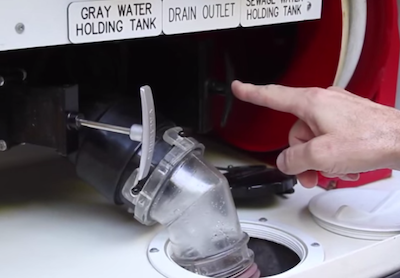Leaving your RV’s gray valve open when fully hooked up allows you to take long showers without worrying about dumping or filling up the gray tank.
But what about sewer smells that can come up from the campground sewer system? Here’s how to get the best of both worlds!
Can You Leave Your Sewer Connection Open?
One of the luxuries of staying in a full-hook-up campground is the ability to use water freely for showers, cooking and washing dishes.
The sewer connection allows you to leave your RV’s gray valve open, so water can run right out instead of filling up your gray tank.
Of course the black valve can NEVER be left open, since “solids” will build up in the black holding tank when the “liquids” run out.
What About the Gray Valve?
But there’s a fair amount of discussion about the gray valve.
Some people recommend that you should never leave the gray valve open either, as it can allow odors from the park’s sewer system up into your RV.

Seems like a shame to have to do that when your RV is connected to a sewer line, especially when you’re staying in a full hook-up site for an extended period of time.
Since the drains under every sink and shower in an RV are equipped with a p-trap, leaving the gray valve open shouldn’t allow odors into the RV.
The water in the traps blocks odors from entering the RV’s living space.
Long periods without use can allow the water in the traps to evaporate, and driving on twisty or bumpy roads can cause it to slosh out.
But both of these situations are easily remedied by running a small amount of water down each drain.
There is, however, a pipe with a direct connection to the sewer hose…. connecting to the tank vents on the roof of the RV.
Roof Venting Causes a Stink
This can allow air from the sewer system to come up through the roof vents. If you’ve ever smelled sewer odors in a full hook-up campground, it’s possible that someone’s RV is venting the park’s sewer system out through their roof.
There is a ridiculously easy way to fully enjoy the luxury of a full hook-up RV park, without the sewer smell.
You can leave your gray valve in the open position so water runs right down the drain.
You don’t have to pay any attention to how full your gray tank is and you don’t have to dump it every few days.
But there’s no chance for sewer odors to escape either. It’s the best of both worlds.
Watch the video to see how we did it!
httpv://youtu.be/dslcXoydeY4
Please use your full hook-up powers responsibly and don’t waste water!




Thanks for the additional info HowToRVgeeks
Just a brief follow-up… Although this wasn’t a video about tank dumping, it is related, and there were some comments and questions about it. If the gray valve is left open, there isn’t any gray water available to flush the sewer hose after dumping the black tank. Here’s how we handle that.
Conserving water and monitoring tank levels are just part of life for most RVers, so it’s a luxury to be able to forget about it once in a while. When we’re in a full hook-up RV park for an extended stay, leaving the gray valve open allows us to take longer showers, while completely ignoring the level in the gray tank. We just use the trick we demonstrated in the video to prevent sewer odors from coming in through the open gray valve.
Then all we need to do is keep an occasional eye on the black tank level. Since we often take the load (sorry) off the black tank by making periodic use of the park’s bathrooms (as long as they’re clean), it takes a solid (sorry again lol) two weeks or more to fill it up. When it shows 3/4 full, we close the gray valve for a day or two, allowing gray water to accumulate in the tank.
When we’re ready to dump, we take a few seconds to put the entire sewer hose back up on the sewer hose support, then dump both tanks, black first of course. Plenty of water has now accumulated in the gray tank, allowing us to flush the sewer hose after dumping the black tank. When we stay in one place for an extended period, we appreciate being able to completely ignore both tanks for two-plus weeks at a time. This way of managing our tanks allows us to do that.
This is a perfectly fine way to handle shorter stays too. After boondocking for extended periods, we’ll sometimes treat ourselves to the luxury of full hook-ups for a week or so, leaving the gray valve open and using the same sewer hose technique. We simply close the gray valve a day or two before we’ll be leaving the park, and dump both tanks on the morning of our departure.